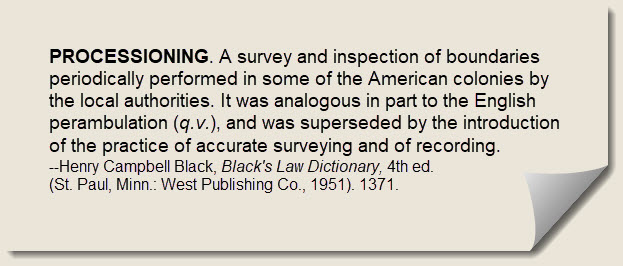
Our past two postings have focused on a critical skill for researchers: Taking research notes that do not simply “extract facts” but also allow us to study the context of those facts.
Yesterday, we challenged you to study a research note detailing the 1755 processioning of lands in Capt. William Christian’s company, Augusta Parish, Augusta County, Virginia. Focusing on the long and boring list of names, we asked: What clues, context, or patterns do you see that would help you understand the person and the society you are researching?
Glenn and Scott accepted the challenge. Both focused on neighborhood patterns and implications of kinship or distance between residences. Today, we’ll build on their observations and consider three issues:
ISSUE 1: LANDOWNERSHIP vs. LEASES
Scott questioned whether our person-of-interest, James Frame, might be “standing in” for, say, a father-in-law. Or, “whether he might be a near neighbor filling in for someone unable to take the processioners around his metes and bounds.”
The wording of the list does indicate that some individuals were “standing in” for the landowner. However, all the individuals whose names are preceded by “For” (i.e., processioning performed or attempted for …) were actual landowners. The law called for the landowner or his representative to be present.* We can distinguish landowners from representatives by the wording of the entry. The first six entries provide good examples:
- For William Scott, present Ro. Cunningham, Walter Davis
- For Walter Davis, present Wm. Scott, Robert Cunningham
- For Robert Cunningham
- For Thos. Black, present Thos. Rutlidge, James Armstrong
- For Wm. Henderson, present Ro. Cunningham, Geo. Caldwell
- For George Rutledge
In the case of Scott’s land and Davis’s land, each was present for the processioning of the other’s tract, suggesting they were particularly keen on ensuring that the boundary markers were accurate. On the other hand, while Cunningham was present for Davis’s and Scott’s processioning, neither Davis nor Scott bothered to attend the walking-off of Cunningham’s land. It is likely that Cunningham shared a line with both Scott and Davis. Once those joint lines were settled in the first two walk-arounds, there was no need for Scott and Davis to be present for checking Cunningham's other lines.
Cunningham, the owner of the third tract, was the only party present for the verification of his bounds. Ditto for George Rutledge, at tract six. This is the most-common situation through the list.
Thomas Black and Wm. Henderson present a different situation:
- For Black’s land, two men were present, Thomas Rutlidge and James Armstrong. Armstrong later appears on the list as a landowner in his own right. Thomas Rutlidge does not. Why was Rutlidge there? Typically, a non-landowning man who attended a processioning was the man leasing that land, while the owner lived elsewhere. (As for why Armstrong was there, when he was not the next name in sequence, he was more likely a “backside neighbor” rather than adjoining on the main road the processioners were following.)
- For Henderson’s land, two men were also present, Ro. Cunningham and Geo. Caldwell. Again, Cunningham appears on the list elsewhere as a landholder, George Caldwell does not. Again, we might suspect that Caldwell was a renter.
Stay tuned tomorrow for issues 2 and 3.
COMMENT:
This post appeared on EE's Facebook page while EE was transitioning to its new website. For the responses generated there, see "Evidence Explained," Facebook (https://www.facebook.com/evidenceexplained/posts/2287180918023944?__tn__=K-R : posted 30 November 2018).
NOTE:
* Virginia's 1661, 1705, and 1710 processioning laws are detailed in William Waller Hening, ed., The Statutes at Large (New York: Printed for the editor, 1823), 2:101–2 (1661/2); 3:305–8 (1705), 529–33 (1710). HTML editions of Hening can be accessed at http://vagenweb.org/hening/. Image copies of the original are available at Archive.org.
HOW TO CITE:
Elizabeth Shown Mills, "Clues from a Processioning List: Part Three," blog post, QuickTips: The Blog @ Evidence Explained (https://www.evidenceexplained.com/quicktips/clues-processioning-list-part-three : posted 30 November 2018).